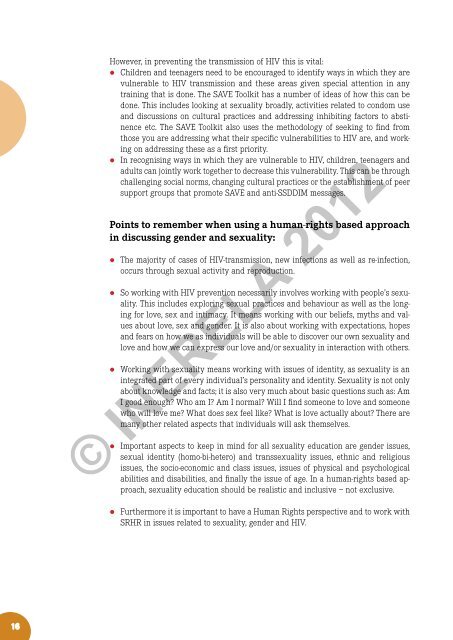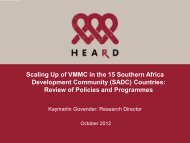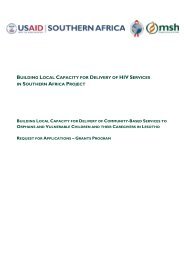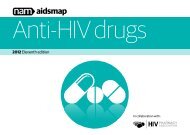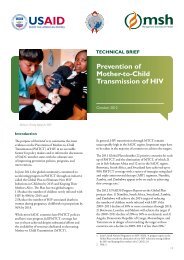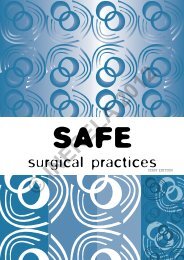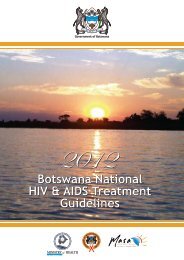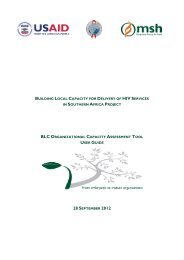Sex, Sexuality and Gender
Sex, Sexuality and Gender
Sex, Sexuality and Gender
You also want an ePaper? Increase the reach of your titles
YUMPU automatically turns print PDFs into web optimized ePapers that Google loves.
However, in preventing the transmission of HIV this is vital:<br />
• zChildren <strong>and</strong> teenagers need to be encouraged to identify ways in which they are<br />
vulnerable to HIV transmission <strong>and</strong> these areas given special attention in any<br />
training that is done. The SAVE Toolkit has a number of ideas of how this can be<br />
done. This includes looking at sexuality broadly, activities related to condom use<br />
<strong>and</strong> discussions on cultural practices <strong>and</strong> addressing inhibiting factors to abstinence<br />
etc. The SAVE Toolkit also uses the methodology of seeking to find from<br />
those you are addressing what their specific vulnerabilities to HIV are, <strong>and</strong> working<br />
on addressing these as a first priority.<br />
• zIn recognising ways in which they are vulnerable to HIV, children, teenagers <strong>and</strong><br />
adults can jointly work together to decrease this vulnerability. This can be through<br />
challenging social norms, changing cultural practices or the establishment of peer<br />
support groups that promote SAVE <strong>and</strong> anti-SSDDIM messages.<br />
Points to remember when using a human-rights based approach<br />
in discussing gender <strong>and</strong> sexuality:<br />
• zThe majority of cases of HIV-transmission, new infections as well as re-infection,<br />
occurs through sexual activity <strong>and</strong> reproduction.<br />
• zSo working with HIV prevention necessarily involves working with people’s sexuality.<br />
This includes exploring sexual practices <strong>and</strong> behaviour as well as the longing<br />
for love, sex <strong>and</strong> intimacy. It means working with our beliefs, myths <strong>and</strong> values<br />
about love, sex <strong>and</strong> gender. It is also about working with expectations, hopes<br />
<strong>and</strong> fears on how we as individuals will be able to discover our own sexuality <strong>and</strong><br />
love <strong>and</strong> how we can express our love <strong>and</strong>/or sexuality in interaction with others.<br />
• zWorking with sexuality means working with issues of identity, as sexuality is an<br />
integrated part of every individual’s personality <strong>and</strong> identity. <strong>Sex</strong>uality is not only<br />
about knowledge <strong>and</strong> facts; it is also very much about basic questions such as: Am<br />
I good enough? Who am I? Am I normal? Will I find someone to love <strong>and</strong> someone<br />
who will love me? What does sex feel like? What is love actually about? There are<br />
many other related aspects that individuals will ask themselves.<br />
• zImportant aspects to keep in mind for all sexuality education are gender issues,<br />
sexual identity (homo-bi-hetero) <strong>and</strong> transsexuality issues, ethnic <strong>and</strong> religious<br />
issues, the socio-economic <strong>and</strong> class issues, issues of physical <strong>and</strong> psychological<br />
abilities <strong>and</strong> disabilities, <strong>and</strong> finally the issue of age. In a human-rights based approach,<br />
sexuality education should be realistic <strong>and</strong> inclusive – not exclusive.<br />
© INERELA 2012<br />
• zFurthermore it is important to have a Human Rights perspective <strong>and</strong> to work with<br />
SRHR in issues related to sexuality, gender <strong>and</strong> HIV.<br />
16


